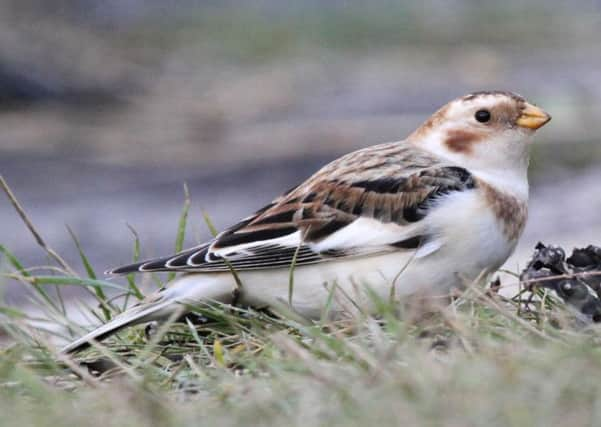Birdwatch: Snow buntings


A flock of at least 80 was seen this week at Wold Newton near Driffield, the largest flock recorded inland in Yorkshire for at least 50 years.
They are best looked for in fields near a trig point on the road to Fordon to the north of Wold Newton. Some corn buntings have also been seen there.
Advertisement
Hide AdAdvertisement
Hide AdSo far this winter there’s been few snow buntings seen along the coast with up to seven seen at Spurn last weekend. Inland there’s been a long-staying individual at Orgreave lagoons, South Yorkshire and small numbers at high points on the North York Moors.
They are very attractive birds, the males with bright white wing patches and underparts which gives the snow bunting its old country name of snowflake.
They feed on short open vegetation and a flock will move in characteristic fashion; the hindmost birds leapfrogging those in front to create a constantly rolling movement.
Snow buntings are the most northerly-breeding of any land bird in the world, nesting in rocky terrain from sea level up to the mountain tops in Greenland. They are so hardy that they return to breeding sites when the temperatures are still as low as minus 20F.
Advertisement
Hide AdAdvertisement
Hide AdA few pairs breed in the British Isles among the highest and remotest of the Scottish mountain ranges, and numbers have increased from fewer than two dozens birds at the end of the 19th century, to between 70 and 100 pairs.
Others seen here belong to the nivalis race from Greenland and Scandinavia and the insulae race from Iceland – 80 per cent of the snow buntings seen here belong to this race.
Numbers spotted in Yorkshire each winter have steadily declined from the 1950s and 1960s when flocks of several hundred were regularly seen at coastal reserves. In the 19th century some of the flocks seen on the Shetland Islands covered several acres.
A single snow bunting, Lapland bunting, 30 corn buntings and 150 yellowhammers were seen at Buckton near Bridlington while three owl species, short-eared, long-eared and little have also been reported. Up to four long-eared owls are on the Fairburn Ings reserve near Castleford.
Advertisement
Hide AdAdvertisement
Hide AdA mixed flock of yellowhammers, reed buntings and either corn buntings or twite is on stubble behind Manor Farm at Micklefield, West Yorkshire.
A great grey shrike and rough-legged buzzard were seen from the Midhope Moor watchpoint, South Yorkshire this week. Another great grey shrike is still on Thorne Moors and a rough-legged buzzard still at Grindale near Bridlington.
A drake green-winged teal was seen at North Duffield Carrs near Selby while a redhead smew was at Fairburn Ings and drake at Pugney’s Country Park.
Large numbers of gannets have moved north along the coast with a record count for January of 1,820 off Flamborough on Sunday. A black redstart was seen at Bempton Cliffs.